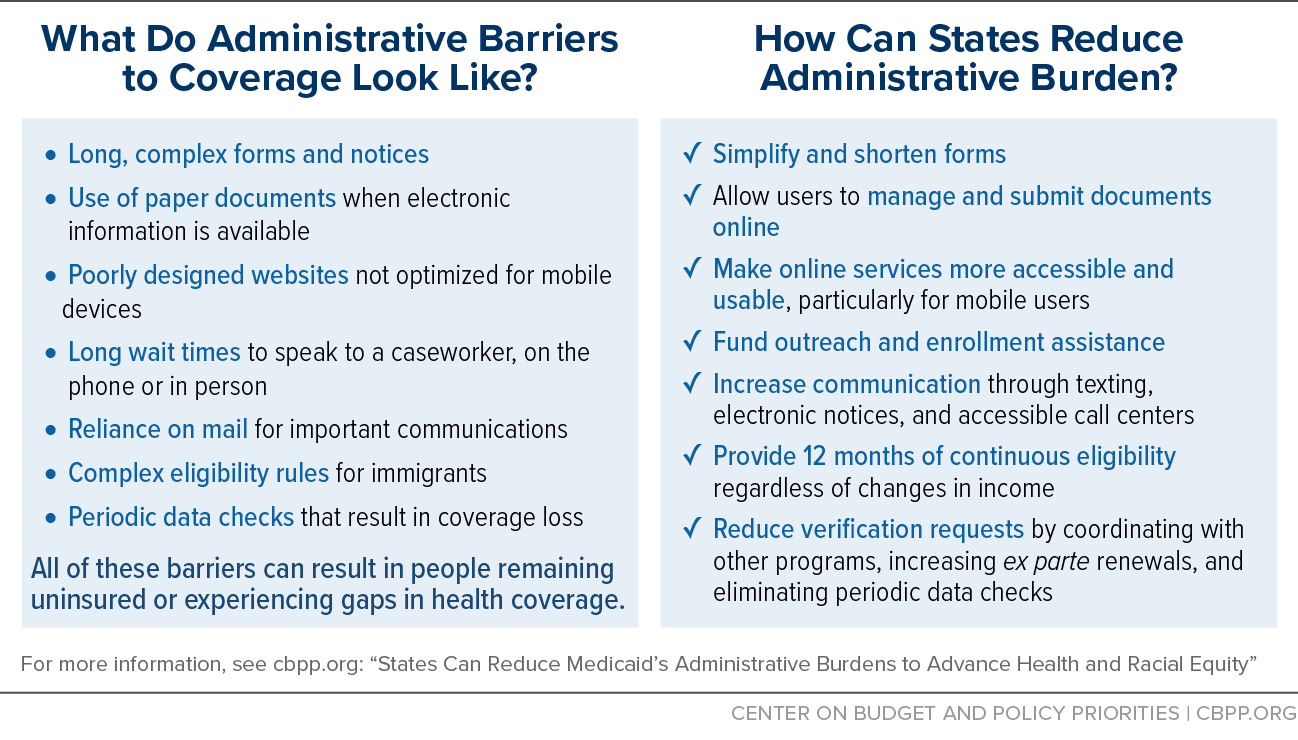BEYOND THE NUMBERS
Reducing Administrative Burdens in Medicaid Is Critical to Achieving Health and Racial Equity
Many people who are eligible for Medicaid can’t enroll or experience gaps in coverage due to administrative burdens such as complex applications and unnecessary requests for documents. And these burdens disproportionately impact people of color. As our new paper explains, state Medicaid agencies and the Centers for Medicare & Medicaid Services (CMS) have a critical role to play in reducing administrative burdens in Medicaid to create more equitable access to Medicaid and advance health equity.
People of color are disproportionately likely to rely on Medicaid for their health coverage: nearly 60 percent of Medicaid enrollees are people of color, compared to 35 percent in employer-sponsored insurance and 25 percent in Medicare. This means that access barriers in Medicaid affect a disproportionate number of people of color, sometimes leaving people without coverage and sometimes making the process more time consuming and difficult than necessary.
Like with many programs, administrative burdens in Medicaid both reflect and perpetuate systemic racism and racial inequity. Administrative burdens have their origins in explicitly racist prior law and prevent eligible people from enrolling and staying enrolled in affordable coverage. Though the Affordable Care Act (ACA) made changes to streamline the Medicaid eligibility and enrollment process and reduce administrative burden, many states have failed to fully implement them.
More than 1 in 4 people under 65 are eligible for Medicaid or the Children’s Health Insurance Program but aren’t enrolled, and many who do manage to enroll experience barriers in staying enrolled. Administrative barriers they face include onerous and unnecessary paperwork requirements, poorly designed websites, and complex eligibility rules and forms, which deter people from completing the application process. Burdens also include long wait times to engage with eligibility workers and agencies’ reliance on mail for important communication, which make it harder both to access important information and to get support to understand it.
State and local governments have proven solutions at their disposal to reduce administrative burdens in Medicaid. States, with guidance and accountability from CMS, should make reducing these burdens a top priority in their Medicaid programs to advance health equity. States can take concrete steps to do so, as we describe here and in the chart below:
- Implementing 12-month continuous eligibility. This would reduce churn (which happens when people lose coverage for procedural reasons and then re-enroll a short time later), eliminate burdensome requests for information based on periodic data checks, and improve people’s access to affordable health care and financial well-being.
- Reducing verification requests by increasing ex parte renewals and coordinating with other programs to expedite eligibility determinations and reduce paperwork burden on Medicaid applicants and enrollees. Under ex parte renewals, an enrollee’s coverage is automatically renewed using electronic or existing data sources with no action required from the enrollee.
- Improving communication with enrollees, particularly for enrollees who face unique barriers such as people whose first language isn’t English. States should use multiple ways to reach people such as text and email, improve their notices and online application and renewal systems, and ensure that applicants and enrollees receive information that’s timely and easy to understand.
- Increasing funding for outreach and enrollment assistance. Community-based organizations, health centers, and other entities work directly with enrollees to provide needed support in navigating the complex enrollment and renewal process. Creating additional pathways for support would reduce the number of inquiries to state Medicaid agencies, in turn increasing caseworker capacity and reducing call center wait times.

